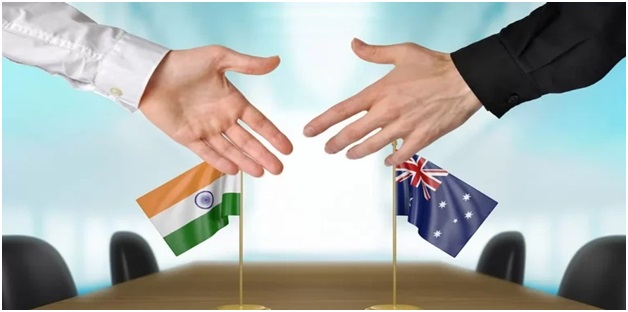India, UK Proposed Free Trade Agreement (FTA) (Indian Express)

- 18 Nov 2023
Why is it in the News?
India and the UK officials are expected to soon hold the next round of talks for the proposed free trade agreement (FTA) to iron out differences on issues such as social security pact, automobiles, medical devices, and the movement of professionals.
Context:
- External Affairs Minister S Jaishankar discussed the India-UK Free Trade Agreement (FTA) with Britain’s Prime Minister Rishi Sunak and Foreign Secretary David Cameron recently.
- These talks were held as the bilateral trade between India and the UK increased to USD 20.36 billion in 2022-23 from USD 17.5 billion in 2021-22.
- When signed, the India-UK FTA will serve as a template for an agreement with India’s second-largest trade partner, the European Union (EU).
- Breaking from the look east policy for trade deals under the UPA that saw widening deficits with Japan, South Korea, and ASEAN countries, the government is counting on economic integration with Western and African nations to fuel export growth.
What is a Free Trade Agreement?
- A Free Trade Agreement (FTA) is a deal between two or more countries aimed at lessening obstacles to the exchange of imports and exports.
- In a free trade arrangement, goods and services can move across borders with minimal government tariffs, quotas, subsidies, or prohibitions.
- This concept stands in contrast to trade protectionism or economic isolationism.
- FTAs can take various forms, such as Preferential Trade Agreements, Comprehensive Economic Cooperation Agreements, and Comprehensive Economic Partnership Agreements (CEPAs).
Expectations from the India-UK Free Trade Agreement:
- Merchandise Trade: Indian products like petroleum, medicines, diamonds, machine parts, airplanes, and wooden furniture worth $6 billion already enjoy tariff-free access to the UK, even without the FTA, so there might be limited additional benefits.
- Services: India aims for immediate advantages, such as obtaining priority visas for Indian professionals on short-term assignments in the UK.
- However, acquiring a substantial number of short-duration business visas may be challenging, given the UK's cautious approach post-Brexit, associating visas with immigration.
- Rules of Origin: Ensuring that products from third countries receive FTA benefits only if they undergo significant transformation in the exporting country.
- India's preference for conservative rules of origin may lead to prolonged discussions and negotiations.
- Government Procurement: Allowing UK producers to sell to India’s government procurement sector would create a level playing field.
- Conversely, Indian firms may face a competitive and restricted government procurement market in the UK, necessitating a cautious approach.
- Labour Standards, Gender, Environment, Digital Trade, IPRs: India should establish domestic rules/standards before committing to these aspects under the FTAs.
- Until then, India must avoid undertaking burdensome obligations on non-trade issues.
Factors Behind the India-UK Free Trade Agreement:
- The China Factor: Disruptions in supply chains during the pandemic highlighted the risks of excessive reliance on China, leading Western companies to adopt a 'China-plus one' approach.
- Australia's tensions with China and the complementary nature of the Indian economy created a compelling case for a trade deal between India and the UK.
- India's RCEP Exit: Following its withdrawal from the China-dominated Regional Comprehensive Economic Partnership (RCEP), India has been actively pursuing trade agreements with the UK, Australia, and the EU to balance its regional engagement against China.
- Brexit Impact: The UK, facing a challenging election in early 2025, sees a trade deal with India as crucial.
- The negotiations are influenced by the post-Brexit landscape as the UK seeks to strengthen its economic ties globally.
What India will Gain from this FTA?
- India’s labour-intensive sectors such as apparel and gems and jewellery have seen a steep decline in market share over the last five years.
- Indian textile exports face tariffs walls as high as 10% in the UK; a trade deal could put India on par with competition such as Bangladesh, and revive textile exports.
- However, the British Parliament has been warned in a report that granting zero-duty access to Indian textiles under the FTA could bring stress on Least Developed Countries such as Bangladesh.
UK Gain in this Deal:
- Past deals with Japan and the ASEAN countries have shown that the elimination of duty does not automatically result in export growth.
- Also, many Indian exports to the UK already enjoy low or zero tariffs, while British exports to India such as cars, Scotch whisky, and wines, face considerable tariffs of 100-150%.
- Tariff reductions on these goods will potentially offer them deeper access into Indian markets.
- Notably, the average tariff on goods imported from India into the UK is 4.2% but the average tariff in India on goods imported from the UK is 14.6%
What are the Challenges in the India-UK FTA?
- Non-tariff barriers: Modern FTAs go beyond tariff reduction. India could use the negotiations to eliminate non-tariff barriers (NTBs) that have historically been a concern for exporters, especially for agri exports.
- NTBs often come in the form of regulations, standards, testing, certification, or pre-shipment inspection that are aimed at protecting human, animal, or plant health and the environment.
- Vegetable and fruit exporters often face strict limits imposed by European economies on pesticides and other contaminants in agri imports.
- In manufacturing too, Indian products face high rejection based on conformity assessments and technical requirements.
- Issue of carbon tax: Like the EU, the UK is looking to impose a levy on metal imports based on carbon emissions.
- An EU-style carbon border adjustment mechanism (CBAM) will hurt India’s exports to the UK even if India wins significant removal of tariffs.
- The UK’s carbon tax could be harsh, as one of its aims is to reduce dependence on Russian energy imports.
